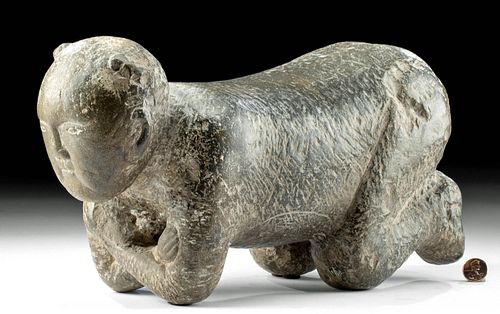Rare Chinese Song Dynasty Stone Pillow Nude Boy Form
Lot 132
About Seller
Artemis Gallery
686 S Taylor Ave, Ste 106
Louisville, CO 80027
United States
Selling antiquities, ancient and ethnographic art online since 1993, Artemis Gallery specializes in Classical Antiquities (Egyptian, Greek, Roman, Near Eastern), Asian, Pre-Columbian, African / Tribal / Oceanographic art. Our extensive inventory includes pottery, stone, metal, wood, glass and textil...Read more
Categories
Estimate:
$9,000 - $13,000
Absentee vs Live bid
Two ways to bid:
- Leave a max absentee bid and the platform will bid on your behalf up to your maximum bid during the live auction.
- Bid live during the auction and your bids will be submitted real-time to the auctioneer.
Bid Increments
| Price | Bid Increment |
|---|---|
| $0 | $25 |
| $300 | $50 |
| $1,000 | $100 |
| $2,000 | $250 |
| $5,000 | $500 |
| $10,000 | $1,000 |
| $20,000 | $2,500 |
| $50,000 | $5,000 |
| $100,000 | $10,000 |
| $200,000 | $20,000 |
About Auction
By Artemis Gallery
Oct 7, 2021
Set Reminder
2021-10-07 10:00:00
2021-10-07 10:00:00
America/New_York
Bidsquare
Bidsquare : Exceptional Antiquities Ethnographic Fine Art
https://www.bidsquare.com/auctions/artemis-gallery/exceptional-antiquities-ethnographic-fine-art-7537
Museum-worthy examples of Egyptian, Greek, Roman, Etruscan, Near Eastern, Far East / Asian, Pre-Columbian, African / Tribal, Oceanic, Native American, Spanish Colonial, Fossils, Ancient Jewelry, Fine / Visual Arts, so much more! Artemis Gallery info@artemisgallery.com
Museum-worthy examples of Egyptian, Greek, Roman, Etruscan, Near Eastern, Far East / Asian, Pre-Columbian, African / Tribal, Oceanic, Native American, Spanish Colonial, Fossils, Ancient Jewelry, Fine / Visual Arts, so much more! Artemis Gallery info@artemisgallery.com
- Lot Description
East Asia, China, Song Dynasty, ca. 960 to 1279 CE. An extremely rare cushion depicting a nude, crouching young boy carved from a dense hard stone. The boy is kneeling and leaning on his elbows with folded arms. The underside of the sculpture includes his genitalia, which is not visible when upright. The rounded face is that of a young boy with a visage comprised of incised eyes, protruding nose, and pudgy dimples. His head is shaved but for his pair of petite top knots, and his ears protrude slightly below. The boy's slightly curved back is smooth from use. Most examples of cushions from the Song Dynasty are made from porcelain, so a stone example is rare find! Babies, especially boys, were considered good fortune, and the wish for male heirs was very prevalent. Perhaps a woman that slept on such a pillow would be blessed with male children. Size: 13" L x 5" W x 6.5" H (33 cm x 12.7 cm x 16.5 cm)
Initially created during the Tang dynasty (618 to 906), by the time of the Ming dynasty (1368 to 1644) ceramic pillows became a familiar domestic item for the middle to upper classes of Chinese society. However, surprisingly, they have been understudied by historians, and consequently, relatively little is understood about their function. Some scholars have suggested that they enabled better sleeping positions in order to preserve a woman's complex hairstyles. Guides published during the later Ming dynasty suggest that they were items associated with elegant lifestyles of the upper class. Gao Lian argued that the porcelain used to create the pillows had health benefits, "power to brighten the eyes and benefit the pupils" (Zunsheng Bajian - Eight Discourses on the Art of Elegant Living). Gao Lian also argued that the pillows helped guide dreams; in China dreams were of great import and oftentimes understood as omens. The pillow was believed to mediate between the earthly and celestial worlds.
Cf. a porcelain example at The Metropolitan Museum of Art, accession number 1991.253.15
This piece has been searched against the Art Loss Register database and has been cleared. The Art Loss Register maintains the world's largest database of stolen art, collectibles, and antiques.
Provenance: private Hawaii, USA collection; ex-M. Kobiashi collection, Hawaii, USA, 1960 to 2000
All items legal to buy/sell under U.S. Statute covering cultural patrimony Code 2600, CHAPTER 14, and are guaranteed to be as described or your money back.
A Certificate of Authenticity will accompany all winning bids.
PLEASE NOTE: Due to recent increases of shipments being seized by Australian & German customs (even for items with pre-UNESCO provenance), we will no longer ship most antiquities and ancient Chinese art to Australia & Germany. For categories of items that are acceptable to ship to Australia or Germany, please contact us directly or work with your local customs brokerage firm.
Display stands not described as included/custom in the item description are for photography purposes only and will not be included with the item upon shipping.
#167399Old inventory label on underside. Felt pads added to elbow and knee to stabilize the piece. Surface wear, scratches, chips, abrasions throughout as shown, with deeper chips along his posterior. Facial features are excellent.Condition
- Shipping Info
-
All shipping is handled in-house for your convenience. Your invoice from Artemis Gallery will include shipping calculation instructions. If in doubt, please inquire BEFORE bidding for estimated shipping costs for individual items.
-
- Buyer's Premium



 EUR
EUR CAD
CAD AUD
AUD GBP
GBP MXN
MXN HKD
HKD CNY
CNY MYR
MYR SEK
SEK SGD
SGD CHF
CHF THB
THB















